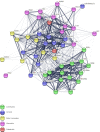Molecular regulations of circadian rhythm and implications for physiology and diseases
- PMID: 35136018
- PMCID: PMC8825842
- DOI: 10.1038/s41392-022-00899-y
Molecular regulations of circadian rhythm and implications for physiology and diseases
Abstract
The term "circadian rhythms" describes endogenous oscillations with ca. 24-h period associated with the earth's daily rotation and light/dark cycle. Such rhythms reflect the existence of an intrinsic circadian clock that temporally orchestrates physiological processes to adapt the internal environment with the external cues. At the molecular level, the circadian clock consists of multiple sets of transcription factors resulting in autoregulatory transcription-translation feedback loops. Notably, in addition to their primary role as generator of circadian rhythm, the biological clock plays a key role in controlling physiological functions of almost all tissues and organs. It regulates several intracellular signaling pathways, ranging from cell proliferation, DNA damage repair and response, angiogenesis, metabolic and redox homeostasis, to inflammatory and immune response. In this review, we summarize findings showing the crosstalk between the circadian molecular clock and some key intracellular pathways, describing a scenario wherein their reciprocal regulation impinges upon several aspects of mammalian physiology. Moreover, based on evidence indicating that circadian rhythms can be challenged by environmental factors, social behaviors, as well as pre-existing pathological conditions, we discuss implications of circadian misalignment in human pathologies, such as cancer and inflammatory diseases. Accordingly, disruption of circadian rhythm has been reported to affect several physiological processes that are relevant to human diseases. Expanding our understanding of this field represents an intriguing and transversal medicine challenge in order to establish a circadian precision medicine.
© 2022. The Author(s).
Conflict of interest statement
The authors declare no competing interests.
Figures



References
-
- Halberg F. Physiologic 24-hour periodicity; general and procedural considerations with reference to the adrenal cycle. Int. Z. Vitaminforsch. Beih. 1959;10:225–296. - PubMed
Publication types
MeSH terms
LinkOut - more resources
Full Text Sources
Medical

